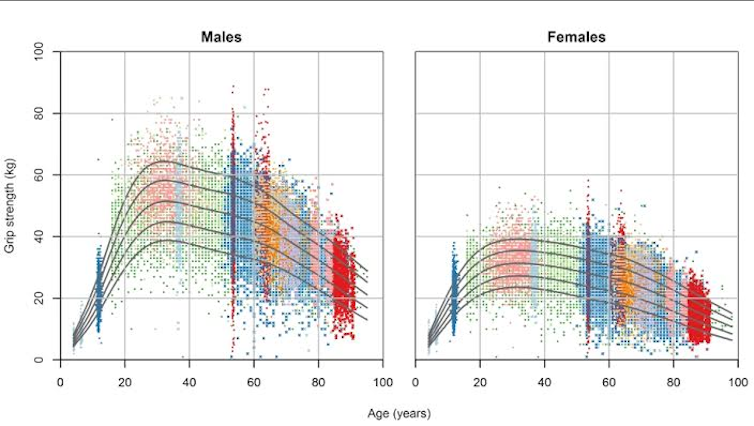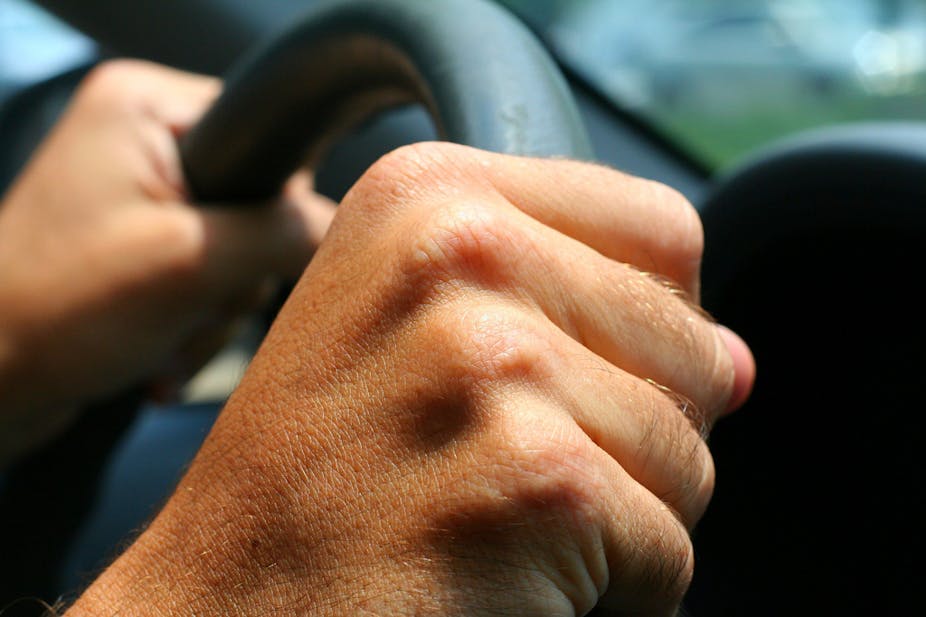More of us are living longer, but a crucial qualifying factor needs to be considered: namely whether this added life expectancy is likely to be times spent in good health. There is considerable evidence that our muscles play an important role in our health during ageing – and grip strength is a good way of measuring how well our muscles are doing.
Numerous studies have shown that people with weaker grip strength in old age are more likely to develop more obvious problems such as losing their independence – from being unable to carry out tasks, for example – but weak grip strength is also associated with dying earlier.
Grip strength builds through young adulthood to reach its peak in our 30s after which it gradually tails away. But it is important to study this across the whole of life as it can indicate lifestyle or environmental factors that can have a bearing – for example, it has been shown those who are more physically active across mid-adulthood have stronger grip as they enter early old age.
But there is relatively little information on the range of normal grip strength across life; existing studies tend to focus on mid-adulthood onwards. Since one in 30 people in the UK takes part in cohort studies, and several studies have included grip strength as part of their assessment, we decided to take a look at this.
In a study published in the journal PLOS ONE, we combined information from 49,964 participants of 12 such studies in order to produce reference charts for grip strength for people aged four to 90.
Reaching your peak
Our results suggested three overall periods for grip strength across life: an increase to a peak in early adult life, broad maintenance through to mid-life, and then a decline from mid-life onwards. Males and females had similar strength in childhood, but from adolescence males become physically stronger on average than females. Men and women both reach their peak strength during their 30s, when the average grip strength for men is 51kg and 31kg for women.

Our reference charts showed that during the peak period, the vast majority of men had a grip strength of greater than 27kg and the vast majority of women had a grip strength of greater than 16kg. We used these values as cut-off points for weak grip strength and then looked to see what proportion of people would be classed as having weak grip at different ages.
As you might expect, weak grip strength becomes increasingly common with age, when about a quarter of people aged 80 in our study fell below these cut-off points.
Grip strength in a clinical setting
At present, grip strength is not widely measured as part of the assessment of an older person’s health. However, a growing recognition of a common clinical condition called sarcopenia, the loss of muscle mass and function with age in which poor muscle function is demonstrated by either weak grip strength or slow walking speed, is likely to change this. And we hope our reference charts will help clinicians with interpreting grip strength measurements.
Research into sarcopenia and its treatment is increasing exponentially. The best current evidence for treatment is using a programme of weight training exercises called progressive resistance training, which incrementally increases the load that a muscle can bear, making it stronger over time. There is now also interest in nutritional interventions and medications.
As well as the role of grip strength in diagnosing sarcopenia in an older person, looking at grip over the life course will help us understand the importance of earlier lifestyle and potential interventions that will improve function in later life. And as we live longer, it is one way we might spend it in better health.

